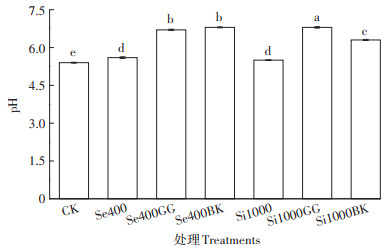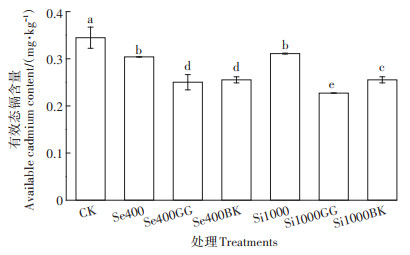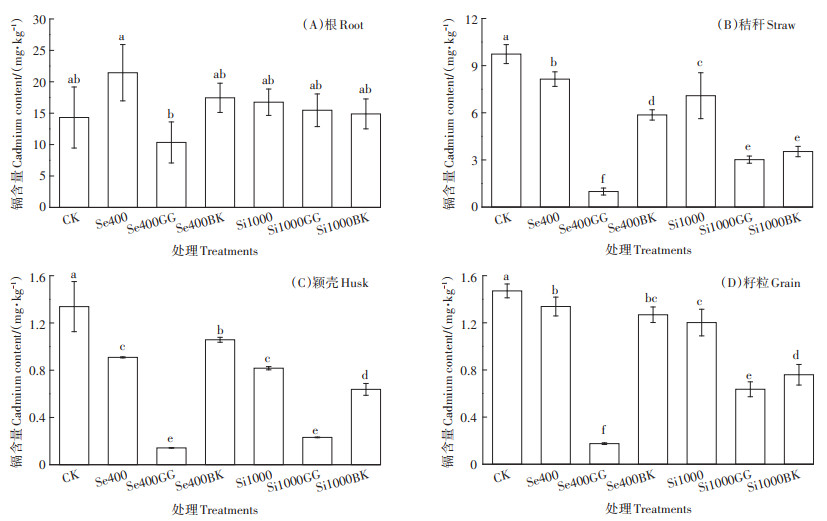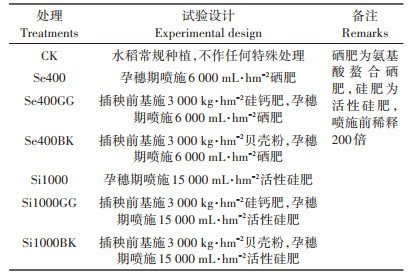2. 广西农业科学院农业资源与环境研究所, 南宁 530007;
3. 广西富硒农业研究中心, 南宁 530005;
4. 广西富硒农产品工程技术研究中心, 南宁 530005;
5. 广西植物营养工程技术研究中心, 南宁 530005
2. Institute of Agricultural Resources and Environment, Guangxi Academy of Agricultural Sciences, Nanning 530007, China;
3. Guangxi Selenium-rich Agricultural Research Center, Nanning 530005, China;
4. Guangxi Selenium-rich Agricultural Products Engineering Technology Research Center, Nanning 530005, China;
5. Guangxi Plant Nutrition Engineering Technology Research Center, Nanning 530005, China
目前,重金属污染问题日益突出,土壤重金属污染具有长期性、隐蔽性、累积性等特点[1-2]。镉(Cd)是土壤中常见的污染物,在我国耕地中点位超标率达到7%。镉具备极强的生物毒性,是一种人体非必需元素[3-4]。水稻是我国第一大粮食作物,对镉具有较强的富集能力[5]。水稻吸收的镉可能通过食物链进入人体,严重危害人体健康。Tsukahara等[6]通过调查发现,食用镉超标的大米是人体内镉的主要来源。因此,为保障稻米的安全,实现镉污染农田的安全利用,研究探索一套高效的镉污染农田修复模式显得尤为重要。
水稻对土壤镉的累积量与土壤中镉的有效态相关,而镉的有效态受到pH、阳离子交换量以及有机质等因素的影响。因此,为了降低土壤中镉的有效态,向土壤中投加钝化剂是目前常用治理措施之一。杨惟薇等[7]研究发现,生物质炭能显著降低土壤中弱酸可提取态镉和可还原态镉含量,提高可氧化态镉和残渣态镉含量。朱健等[8]通过原位固定修复试验发现,硅藻土在添加量为30 g·kg-1时,土壤中的有效态镉含量显著降低。叶面阻隔技术是近些年阻隔农作物对重金属吸收的新方法[9]。王世华等[10]发现在水稻苗期、分蘖期、抽穗期3个生长时期喷施纳米硅可以显著降低水稻籽粒中镉、铅、铜、锌的含量。刘家豪等[11]通过田间试验研究发现,叶面喷施硅可以使水稻籽粒镉含量降低28%~50%。
在镉污染较为严重的农田中,使用单一的处理技术往往很难使稻米镉含量达到《食品安全国家标准食品中污染物限量》(GB 2762—2017)的要求。因此,联合修复技术往往更受青睐。本研究采用大田试验的方法,选用叶面阻隔联合钝化修复技术,选用硒、硅叶面肥作为叶面阻隔剂,硅钙肥和贝壳粉为钝化材料,研究其联合施用对我国南方典型中轻度镉污染农田中水稻吸收镉的影响,并探寻最优搭配,以期为重金属镉污染农田的稻米安全生产提供理论指导。
1 材料与方法 1.1 供试材料供试水稻品种为稻香优——莉晶香。叶面硒肥为广西农业科学院农业环境与资源研究所提供的氨基酸螯合硒肥,含硒量0.26%,pH 6.5。叶面活性硅肥由广东省生态环境技术研究所提供,硅含量为0.25%,pH 6.2。硅钙肥由湖南豫园公司提供,硅、钙含量均为30%,pH 11.0。贝壳粉由北海立地公司提供,为牡蛎壳粉末,pH 10.1。
1.2 研究区域试验区位于广西壮族自治区贵港市桂平市石龙镇,该地区为亚热带季风气候,年平均降雨量1 726.7 mm,年平均气温21.4 ℃。试验区土壤基本理化性质:pH 5.8,有效磷15.0 mg·kg-1,速效钾165.4 mg·kg-1,镉全量1.12 mg·kg-1,有效态镉0.43 mg·kg-1。
1.3 试验设计试验于2018年4—7月进行,共设置了7个处理(表 1)。各材料用量依据本团队前期研究结果确定。试验小区面积50 m2(5 m×10 m),每个处理设置3个重复。小区四周起垄并用聚乙烯薄膜相互间隔,防止小区之间水、肥相互渗透。水稻种子用5%次氯酸钠溶液消毒,用自来水冲洗后催芽。在当地育秧厂长至二叶一心时选取均匀一致的幼苗进行移栽。每个小区设置单独的进、排水口,水稻的施肥以及水肥管理都根据当地的常规标准进行。样品于7月15日水稻成熟期采集,每个小区随机选取6个采样点,每个点采集三株水稻。将植株样分成水稻籽粒、颖壳、秸秆、根四部分,用去离子水冲洗后于烘箱内105 ℃杀青30 min,然后70 ℃烘至恒质量。将样品粉碎后过60目筛装入自封袋备用。土壤样品在采集水稻样品当日采集,在采集水稻样品的点位处直接采集水稻根区土壤。在阴凉处风干后,粉碎研磨过10目筛装入自封袋备用。
|
|
表 1 试验处理及试验设计 Table 1 Treatments and experimental design |
植株样品镉的测定:称取0.200 0 g植物样品于50 mL锥形瓶中,加入HNO3-HClO4(VHNO3:VHClO4=4:1)消解后用石墨炉原子吸收仪测定镉含量,使用四川大米标准样品(GBW10044)进行质量控制。
土壤pH值的测定:采用2.5:1水土比-pH计测定土壤pH值[12]。
土壤有效态镉含量测定:称取5.00 g过2 mm孔径筛风干土壤样品于100 mL具塞锥形瓶中,加入25.00 mL DTPA提取剂(0.005 mol·L-1 DTPA-0.1 mol·L-1 TEA-0.01 mol·L-1 CaCl2),以180 r·min-1的速度在室温下振荡2 h,离心后过滤,用原子吸收分光光度计测定上清液镉含量。
1.5 数据处理和计算试验数据采用Excel 2013进行计算,用Origin 9.0作图。不同处理之间的统计分析及方差分析用IBM SPSS Statistics 25.0软件计算。转运系数(Transfer factor,TF)是植物地上部某元素含量与植物地下部某元素含量之比,常用来评价植物将重金属从下部向上部的运输能力,也常用来作为筛选低镉积累水稻品种的指标[13]。富集系数(Bioconcentration factor,BF)是植物各组织某元素含量与土壤中某元素含量之比。

|
由图 1、图 2可知,与CK处理相比,单独喷施叶面阻隔剂的Se400和Si1000处理土壤pH值略有升高,上升了0.2个和0.1个pH单位,叶面肥落入土壤、施肥不均匀或采样误差都有可能造成这种现象,土壤有效态镉含量下降了8.98%和6.90%。叶面阻隔联合钝化技术的Se400GG、Se400BK、Si1000GG和Si1000BK处理土壤pH值显著上升,土壤有效镉含量分别降低了25.08%、23.56%、31.99%和19.24%。其中Si1000GG处理土壤pH值上升最明显,有效镉含量降幅最大。

|
不同小写字母表示处理间差异显著(P < 0.05)。下同 Different lowercase letters indicate significant differences among treatments(P < 0.05). The same as follow 图 1 不同处理对土壤pH值的影响 Figure 1 pH in soil under different treatments |

|
图 2 不同处理对土壤有效态镉含量的影响 Figure 2 Content of available cadmium in soil under different treatments |
由图 3可知,与对照CK处理相比,各处理水稻地上各组织的镉含量都发生了不同程度的变化,其中,单独喷施叶面阻隔剂的Se400和Si1000处理水稻籽粒镉含量仅下降9.03%和18.28%;颖壳镉含量下降32.10%和38.95%;秸秆镉含量下降16.35%和27.18%。而叶面阻隔联合钝化技术的Se400GG、Se400BK、Si1000GG、Si1000BK处理水稻籽粒镉含量降低88.13%、13.77%、56.77%和48.39%;颖壳镉含量降低89.35%、20.96%、82.71%、52.34%;秸秆镉含量降低89.82%、39.77%、69.00%和63.69%。其中,Se400GG处理对水稻地上部的降镉效果最好,其水稻籽粒镉含量降至(0.18±0.01)mg·kg-1,低于《食品安全国家标准食品中污染物限量》(GB 2762—2017)中规定的大米镉限量值(0.2 mg·kg-1)。另外,除了Se400GG处理,其他处理水稻根部镉含量均有不同程度的上升但差异不显著(P>0.05),且叶面阻隔联合钝化技术的处理水稻根部镉含量均低于单独叶面阻隔的处理。由此可知,叶面阻隔联合钝化技术,尤其是Se400GG处理能更有效地降低水稻各组织镉含量。

|
图 3 不同处理对水稻根、秸秆、颖壳和籽粒镉含量的影响 Figure 3 Content of cadmium in rice root, straw, husk and grain under different treatments |
由表 2可知,与CK处理相比,单独喷施叶面阻隔剂的Se400和Si1000处理TF根到秸秆下降了46.58%和38.36%,叶面阻隔联合钝化技术的Se400GG、Se400BK、Si1000GG和Si1000BK处理TF根到秸秆下降84.93%、54.79%、72.60%和67.12%。叶面阻隔联合钝化技术处理的TF根到秸秆降幅明显大于单独喷施叶面阻隔剂的处理。但是,各处理对于TF秸秆到壳、TF壳到籽粒大多没有明显的影响,这可能是受到了水稻品种的影响。由表 3可知,与CK相比,各处理明显降低了水稻地上部各组织的镉富集系数。叶面阻隔联合钝化技术的处理水稻各组织的镉富集系数明显低于单独喷施叶面阻隔剂的处理。由此可知,叶面阻隔联合钝化技术能更有效地阻隔水稻对镉的吸收和转运。
|
|
表 2 不同处理对水稻镉转运系数的影响 Table 2 Transfer factor of cadmium in rice under different treatments |
|
|
表 3 不同处理对水稻镉富集系数的影响 Table 3 Bioconcentration factor of cadmium in rice under different treatments |
镉是水稻生长的非必需元素,可借助铁、锌、锰、磷、硅等必需元素的转运通道进入水稻根部,并向上输送至籽粒中[14]。本研究中,叶面喷施硅肥分别使水稻秸秆、颖壳、籽粒镉含量降低了27.18%、38.95%、18.28%。叶面喷施硒肥分别使水稻秸秆、颖壳、籽粒中镉含量降低了16.35%、32.10%、9.03%。主要是由于水稻作为一种典型的喜硅作物,硅会以单硅酸的形式被水稻快速吸收[15],在水稻一些不活跃的组织,比如中柱鞘、木质部和韧皮部的细胞壁内皮层与镉形成硅镉沉淀[16],从而抑制镉在水稻内的转运,减轻镉对水稻的毒害作用。徐奕等[17]研究表明,叶面喷施硅肥后,糙米、颖壳和秸秆镉含量最大可分别降低34.9%、30.1%和34.0%。黄崇玲等[18]研究表明,喷施0.2%硅胶溶液可以使稻米中镉含量下降60.55%。硒具有的阻隔功能与硅类似,而且硒能增强水稻木质素合成基因OSPAL、OsCoMT、Os4CL3的表达,具有提高水稻细胞木质素、细胞壁厚度和机械强度的作用,利于镉在细胞壁的沉积与固定[19-20]。Wan等[21]研究发现,亚硒酸能大幅降低水稻对镉的吸收并降低镉在水稻内的转运系数。刘永贤等[22]通过大田实验,研究发现在水稻孕穗期和抽穗期前3 d各喷施一次硒可以使水稻籽粒镉含量降低83.33%。与其相比本研究中,单独喷施硒肥的Se400处理对水稻地上部镉含量的降幅更低,推测是由水稻间的品种差异造成的。刘永贤等[22]在研究喷施硒肥对水稻积累镉的影响时也发现,喷施硒肥能显著抑制百香139水稻籽粒对镉的积累,但是对中广香1号稻米积累镉的影响不明显。由此可见,水稻的品种是硒肥对水稻籽粒镉积累影响的重要因素。试验中Se400处理水稻根部镉含量显著上升,可能是因为喷施硒肥阻隔了根部吸收的镉向上转移,Se400处理水稻TF根到秸秆下降、BF根上升也证明了这种情况存在的可能性。
相较于单独进行叶面阻隔的处理,叶面阻隔联合钝化处理的水稻地上部镉含量明显降低。土壤的理化性质(如pH、CEC、有机质等)和吸附能力是影响水稻吸收重金属的重要因素。本研究中,贝壳粉的主要成分是CaCO3[23],当其进入土壤环境后,CaCO3在土壤溶液中溶解会使土壤的pH升高,与重金属生成沉淀[23]。同时,贝壳粉表面的Ca2+会与土壤中的镉离子发生离子交换反应产生碳酸镉沉淀[24],从而使土壤镉有效态含量降低。此外,贝壳粉是由文石晶体交叉堆砌而成的较为有序的多重微层结构,晶体层间的孔隙使其对重金属具有优异的吸附性能[23],从而增强了土壤对镉的吸附,减少其向水稻体内迁移。而对于硅钙肥来说,一方面,其中所含有的硅酸根离子会与镉发生反应形成硅酸化合物沉淀[25];另一方面,土壤中的硅会以单硅酸的形式被水稻吸收,从而阻隔镉向水稻的转运。贾倩等[26]通过盆栽试验研究发现,向土壤中施加硅钙肥,会增加水稻植株内硅的含量,并且能有效降低水稻各组织的镉含量。
4 结论(1)单独喷施叶面肥能有效降低水稻地上部的镉含量,并减弱镉从根到秸秆的转运。相较于硒,硅作为叶面肥能更有效地降低水稻地上部的镉含量,但硒对镉从根到秸秆的转运有更强的阻隔作用。
(2)叶面喷施氨基酸螯合硒营养液肥和活性硅肥与土施硅钙肥和贝壳粉两项措施联合,相较于单独进行叶面阻隔的处理,能更显著地降低水稻籽粒的镉含量,并减弱镉从根到秸秆的转运。
(3)叶面喷施氨基酸螯合硒营养液联合土施硅钙肥能最大程度地降低水稻籽粒的镉含量,与对照处理相比,其籽粒镉含量下降88.13%,为(0.18±0.01)mg· kg-1,低于《食品安全国家标准食品中污染物限量》(GB 2762—2017)中规定的大米镉限量值。此技术可尝试在同类型重金属污染农田中推广。
| [1] |
王加华, 张峰, 马烈. 重金属污染土壤稳定化修复药剂研究进展[J]. 中国资源综合利用, 2016, 34(2): 49-52. WANG Jia-hua, ZHANG Feng, MA Lie. Research progress of stabilization binder for heavy metals contaminated soil remediation[J]. China Resources Comprehensive Utilization, 2016, 34(2): 49-52. |
| [2] |
赵述华, 陈志良, 张太平, 等. 重金属污染土壤的固化/稳定化处理技术研究进展[J]. 土壤通报, 2013, 44(6): 1531-1536. ZHAO Shu-hua, CHEN Zhi-liang, ZHANG Tai-ping, et al. Advances in solidification/stabilization technology treatment of heavy metals in contaminated soil[J]. Chinese Journal of Soil Science, 2013, 44(6): 1531-1536. |
| [3] |
He S Y, He Z L, Yang X E, et al. Soil biogeochemistry, plant physiology, and phytoremediation of cadmium-contaminated soils[J]. Advances in Agronomy, 2015, 134: 135-225. DOI:10.1016/bs.agron.2015.06.005 |
| [4] |
高敏, 周俊, 刘海龙, 等. 叶面喷施硅硒联合水分管理对水稻镉吸收转运特征的影响[J]. 农业环境科学学报, 2018, 37(2): 215-222. GAO Min, ZHOU Jun, LIU Hai-long, et al. Effect of silica and selenite foliar sprays on the uptake and transport of cadmium by rice under water management[J]. Journal of Agro-Environment Science, 2018, 37(2): 215-222. |
| [5] |
Chaney R L, Reeves P G, Ryan J A, et al. An improved understanding of soil Cd risk to humans and low cost methods to phytoextract Cd from contaminated soils to prevent soil Cd risks[J]. Biometals, 2004, 17(5): 549-553. DOI:10.1023/B:BIOM.0000045737.85738.cf |
| [6] |
Tsukahara T, Ezaki T, Moriguchi J, et al. Rice as the most influential source of cadmium intake among general Japanese population[J]. Science of the Total Environment, 2003, 305(1/2/3): 41-51. |
| [7] |
杨惟薇, 张超兰, 曹美珠, 等. 4种生物炭对镉污染潮土钝化修复效果研究[J]. 水土保持学报, 2015, 29(1): 239-243. YANG Wei-wei, ZHANG Chao-lan, CAO Mei-zhu, et al. Immobilization and remediation of cadmium contaminated soil with four kinds of biochars[J]. Journal of Soil and Water Conservation, 2015, 29(1): 239-243. |
| [8] |
朱健, 王平, 林艳, 等. 不同产地硅藻土原位控制土壤镉污染差异效应与机制[J]. 环境科学, 2016, 37(2): 717-725. ZHU Jian, WANG Ping, LIN Yan, et al. Differential effect and mechanism of in situ immobilization of cadmium contamination in soil using diatomite produced from different areas[J]. Environmental Science, 2016, 37(2): 717-725. |
| [9] |
Liu C P, Li F B, Luo C L, et al. Foliar application of two silica sols reduced cadmium accumulation in rice grains[J]. Journal of Hazardous Materials, 2009, 161(2/3): 1466-1472. |
| [10] |
王世华, 罗群胜, 刘传平, 等. 叶面施硅对水稻籽实重金属积累的抑制效应[J]. 生态环境, 2007, 16(3): 875-878. WANG Shi-hua, LUO Qun-sheng, LIU Chuan-ping, et al. Effects of leaf application of nanometer silicon to the accumulation of heavy metals in rice grains[J]. Ecology and Environment, 2007, 16(3): 875-878. |
| [11] |
刘家豪, 赵龙, 孙在金, 等. 叶面喷施硫对镉污染土壤中水稻累积镉的机制研究[J]. 环境科学研究, 2019, 32(12): 2132-2338. LIU Jia-hao, ZHAO Long, SUN Zai-jin, et al. Protective effect of foliar application of sulfur on rice under the stress of Cd[J]. Research of Environmental Sciences, 2019, 32(12): 2132-2338. |
| [12] |
鲍士旦. 土壤农化分析[M]. 3版. 北京: 中国农业出版社, 2010. BAO Shi-dan. Agrochemical analysis of soil[M]. 3rd Edition. Beijing: China Agriculture Press, 2010. |
| [13] |
陈喆, 铁柏清, 雷鸣, 等. 施硅方式对稻米镉阻隔潜力研究[J]. 环境科学, 2014, 35(7): 2762-2770. CHEN Zhe, TIE Bo-qing, LEI Ming, et al. Phytoexclusion potential studies of Si fertilization modes on rice cadmium[J]. Environmenntal Science, 2014, 35(7): 2762-2770. |
| [14] |
于焕云, 崔江虎, 乔江涛, 等. 稻田镉砷污染阻控原理与技术应用[J]. 农业环境科学学报, 2018, 37(7): 1418-1426. YU Huan-yun, CUI Jiang-hu, QIAO Jiang-tao, et al. Principle and technique of arsenic and cadmium pollution control in paddy field[J]. Journal of Agro-Environment Science, 2018, 37(7): 1418-1426. |
| [15] |
Liang Y C, Sun W C, Zhu Y G, et al. Mechanisms of silicon-mediatedalleviation of abiotic stresses in higher plants:A review[J]. Environmental Pollution, 2007, 147(2): 422-428. DOI:10.1016/j.envpol.2006.06.008 |
| [16] |
Shi X, Zhang C, Wang H, et al. Effect of Si on the distribution of Cd in rice seedlings[J]. Plant & Soil, 2005, 272(1/2): 53-60. |
| [17] |
徐奕, 李剑睿, 黄青青, 等. 坡缕石钝化与喷施叶面硅肥联合对水稻吸收累积镉效应影响研究[J]. 农业环境科学学报, 2016, 35(9): 1633-1641. XU Yi, LI Jian-rui, HUANG Qing-qing, et al. Effect of palygorskite immobilization combined with foliar silicon fertilizer application on Cd accumulation in rice[J]. Journal of Agro-Environment Science, 2016, 35(9): 1633-1641. |
| [18] |
黄崇玲, 雷静, 顾明华, 等. 土施和喷施硅肥对镉污染农田水稻不同部位镉含量及富集的影响[J]. 西南农业学报, 2013, 26(4): 1532-1535. HUANG Chong -ling, LEI Jing, GU Ming-hua, et al. Effects of soil and foliar applications of silicon fertilizer on Cd content and its bioconcentration factors in different parts of rice growing in cadmium contaminated soil[J]. Southwest China Journal of Agricultural Sciences, 2013, 26(4): 1532-1535. |
| [19] |
Huang B F, Xin J L, Dai H W, et al. Effects of interaction between cadmium(Cd)and selenium(Se)on grain yield and Cd and Se accumulation in a hybrid rice(Oryza sativa) system[J]. Journal of Agricultural and Food Chemistry, 2017, 65(43): 9537-9546. DOI:10.1021/acs.jafc.7b03316 |
| [20] |
Gao M, Zhou J, Liu H, et al. Foliar spraying with silicon and selenium reduces cadmium uptake and mitigates cadmium toxicity in rice[J]. Science of the Total Environment, 2018, 631/532: 1100-1108. |
| [21] |
Wan Y, Yao Y, Qi W, et al. Cadmium uptake dynamics and translocation in rice seedling:Influence of different forms of selenium[J]. Eco-toxicology & Environmental Safety, 2016, 133: 127-134. |
| [22] |
刘永贤, 潘丽萍, 黄雁飞, 等. 外源喷施硒与硅对水稻籽粒镉累积的影响[J]. 西南农业学报, 2017, 30(7): 1588-1592. LIU Yong-xian, PAN Li-ping, HUANG Yan-fei, et al. Effects of selenium or silicon foliar fertilizer on cadmium accumulation in rice[J]. Southwest China Journal of Agricultural Sciences, 2017, 30(7): 1588-1592. |
| [23] |
张琢, 王梅, 任杰, 等. 贝壳粉对污染土壤中Pb、Zn、Cd的稳定化作用[J]. 环境污染与防治, 2016, 38(1): 14-18. ZHANG Zhuo, WANG Mei, REN Jie, et al. Effects of sea shell powder on the stabilization of Pb, Zn and Cd in contaminated soil[J]. Environmental Pollution & Control, 2016, 38(1): 14-18. |
| [24] |
Papadopoulos P, Rowell D L. The reactions of cadmium with calciumcarbonate surface[J]. Journal of Soil Science, 1988, 39(1): 23-36. |
| [25] |
Alin S, Li Z J, Zhang J, et al. Silicon-enhanced resistance to cadmium toxicity in Brassica chinensis L. is attributed to Si-suppressed cadmium uptake and transport and Si-enhanced antioxidant defense capacity[J]. Journal of Hazardous Materials, 2009, 172: 74-83. DOI:10.1016/j.jhazmat.2009.06.143 |
| [26] |
贾倩, 胡敏, 张洋洋, 等. 硅钙肥对水稻吸收铅、镉的影响研究[J]. 环境科学与技术, 2017, 40(6): 24-30. JIA Qian, HU Min, ZHANG Yang-yang, et al. Effect of silicon-calcium fertilizer on Pb and Cd absorption by rice in heavy metal polluted farmland[J]. Environmental Science & Technology, 2017, 40(6): 24-30. |
 2020, Vol. 37
2020, Vol. 37





